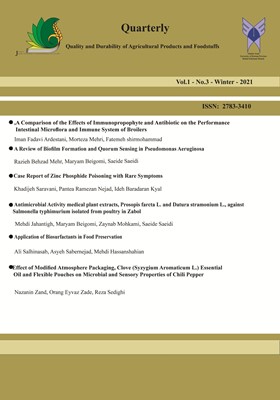Application of Biosurfactants in Food Preservation
Subject Areas : Shelf Life of Food Products and Agricultural Productions
Ali Salhinasab
1
,
Asyeh Sabernejad
2
,
Mehdi Hassanshahian
3
*
![]()
1 - M.S, Department of Biology, Faculty of Science, Shahid Bahonar University of Kerman, Kerman, Iran
2 - M.S, Department of Biology, Faculty of Science, Shahid Bahonar University of Kerman, Kerman, Iran
3 - Professor, Department of Biology, Faculty of Sciences, Shahid Bahonar University of Kerman, Kerman, Iran
Keywords: Bibliometric, Biosurfactant, Food Preservation,
Abstract :
Surfactants have received much attention as amphipathic compounds due to their widespread use. The production of surfactants by microorganisms (biosurfactants) has advantages such as toxicity less than chemical methods. Due to its antimicrobial and anti-biofilm properties, the use of biosurfactants in food preservation can be very valuable. In this study, a review, as well as a bibliometric analysis of the use of biosurfactants in food storage, has been performed. Documents were collected from the Scopus database and then analyzed using VOSviewer software. Examining the documents, it was found that only 15 documents have been published in this regard. The share of immunology and microbiology is higher than other fields, and India has published the most documents in this database with 6 documents. The small number of documents and the lack of documents such as conference papers and book chapters can indicate the lack of research done despite the great importance of the subject matter.
1- Donio M, Ronica S, Viji VT, Velmur-ugan S, Jenifer JA, Michaelbabu M, et al. Isolation and characterization of halophilic Bacillus sp. BS3 able to produce pharm-acologically important biosurfactants. Asi-an Pacific journal of tropical medicine. 2013;6(11):876-83.
2- Bodour AA, Guerrero-Barajas C, Jiorle BV, Malcomson ME, Paull AK, Somogyi A, et al. Structure and characterization of flavolipids, a novel class of biosurfactants produced by Flavobacterium sp. strain MTN11. Applied and environmental micr-obiology. 2004;70(1):114-20.
3- Satpute SK, Banat IM, Dhakephalkar PK, Banpurkar AG, Chopade BA. Biosur-factants, bioemulsifiers and exopolysacc-harides from marine microorganisms. Bio-technology advances. 2010;28(4):436-50.
4- Bezza FA, Chirwa EMN. Production and applications of lipopeptide biosurfac-tant for bioremediation and oil recovery by Bacillus subtilis CN2. Biochemical engine-ering journal. 2015;101:168-78.
5- Md F. Biosurfactant: production and application. Journal of Petroleum and Environmental Biotechnology. 2012;3(4): 124.
6- Adamczak M, odzimierz Bednarski W. Influence of medium composition and aer-ation on the synthesis of biosurfactants produced by Candida antarctica. Biotech-nology Letters. 2000;22(4):313-6.
7- Desai JD, Banat IM. Microbial prod-uction of surfactants and their commercial potential. Microbiology and Molecular bio-logy reviews. 1997;61(1):47-64.
8- Zinjarde SS, Pant A. Emulsifier from a tropical marine yeast, Yarrowia lipolytica NCIM 3589. Journal of Basic Microbio-logy: An International Journal on Bioche-mistry, Physiology, Genetics, Morphology, and Ecology of Microorganisms. 2002; 42(1):67-73.
9- Elliot MA, Karoonuthaisiri N, Huang J, Bibb MJ, Cohen SN, Kao CM, et al. The chaplins: a family of hydrophobic cell-surface proteins involved in aerial myceli-um formation in Streptomyces coelicolor. Genes & development. 2003;17(14):1727-40.
10- Wösten HA, Scholtmeijer K. Applica-tions of hydrophobins: current state and perspectives. Applied microbiology and biotechnology. 2015;99(4):1587-97.
11- Dokouhaki M, Hung A, Kasapis S, Gras SL. Hydrophobins and chaplins: Nov-el bio-surfactants for food dispersions a review. Trends in Food Science & Techno-logy. 2021;111:378-87.
12- Gaur VK, Regar RK, Dhiman N, Gaut-am K, Srivastava JK, Patnaik S, et al. Biosynthesis and characterization of soph-orolipid biosurfactant by Candida spp.: Application as food emulsifier and antiba-cterial agent. Bioresource technology. 2019;285.
13- Ribeiro BG, dos Santos MM, Pinto MIS, Meira HM, Durval IJB, Guerra JMC, et al. Production and optimization of the extraction conditions of the biosurfactant from Candida utilis UFPEDA1009 with potential application in the food industry. Chemical Engineering Transactions. 2019; 74:1477-82.
14- Sharma V, Garg M, Talukdar D, Th-akur P, Henkel M, Sharma D, et al. Preservation of microbial spoilage of food by biosurfactant-based coating. Asian Journal of Pharmaceutical and Clinical Research. 2018;11(Special Issue 2):98-101.
15- Giri SS, Sen SS, Jun JW, Sukumaran V, Park SC. Role of Bacillus licheniformis VS16-derived biosurfactant in mediating immune responses in carp rohu and its application to the food industry. Frontiers in Microbiology. 2017;8(MAR).
16- Joshi S, Bharucha C, Desai AJ. Production of biosurfactant and antifungal compound by fermented food isolate Baci-llus subtilis 20B. Bioresource Technology. 2008;99(11):4603-8.
17- Anjum F, Gautam G, Edgard G, Negi S. Biosurfactant production through Bacill-us sp. MTCC 5877 and its multifarious applications in food industry. Bioresource Technology. 2016;213:262-9.
18- Mohd Isa MH, Shamsudin NH, Al-Shorgani NKN, Alsharjabi FA, Kalil MS. Evaluation of antibacterial potential of bio-surfactant produced by surfactin-producing Bacillus isolated from selected Malaysian fermented foods. Food Biotechnology. 2020;34(1):1-24.
19- Rani M, Weadge JT, Jabaji S. Isolation and Characterization of Biosurfactant-Pro-ducing Bacteria From Oil Well Batteries With Antimicrobial Activities Against Food-Borne and Plant Pathogens. Frontiers in Microbiology. 2020;11.
20- Sakr EAE, Ahmed HAE, Abo Saif FAA. Characterization of low-cost glycoli-poprotein biosurfactant produced by Lacto-bacillus plantarum 60 FHE isolated from cheese samples using food wastes through response surface methodology and its pot-ential as antimicrobial, antiviral, and anti-cancer activities. International Journal of Biological Macromolecules. 2021;170:94-106.
21- Kiran GS, Priyadharsini S, Sajayan A, Priyadharsini GB, Poulose N, Selvin J. Production of lipopeptide biosurfactant by a marine Nesterenkonia sp. and its appli-cation in food industry. Frontiers in Micro-biology. 2017;8(JUN).
22- Ribeiro BG, Guerra JMC, Sarubbo LA. Potential Food Application of a Biosur-factant Produced by Saccharomyces cerev-isiae URM 6670. Frontiers in Bioeng-ineering and Biotechnology. 2020;8.
23- de Oliveira OJ, da Silva FF, Juliani F, Barbosa LCFM, Nunhes TV. Bibliometric method for mapping the state-of-the-art and identifying research gaps and trends in literature: an essential instrument to sup-port the development of scientific projects. Scientometrics Recent Advances: Intech-Open; 2019.
24- Van Eck NJ, Waltman L. Software survey: VOSviewer, a computer program for bibliometric mapping. scientometrics. 2010;84(2):523-38.
_||_
